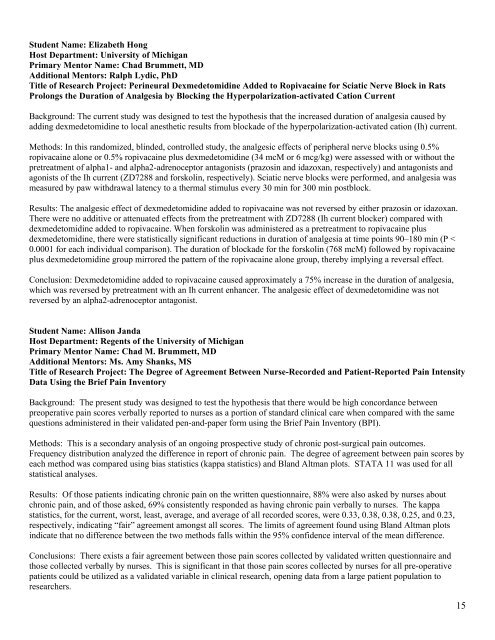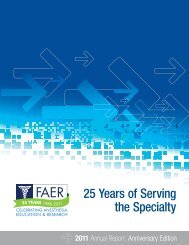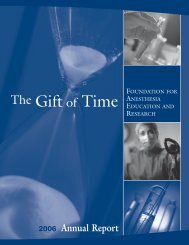2010 MSARF Symposium Participants - Foundation for Anesthesia ...
2010 MSARF Symposium Participants - Foundation for Anesthesia ...
2010 MSARF Symposium Participants - Foundation for Anesthesia ...
You also want an ePaper? Increase the reach of your titles
YUMPU automatically turns print PDFs into web optimized ePapers that Google loves.
Student Name: Elizabeth Hong<br />
Host Department: University of Michigan<br />
Primary Mentor Name: Chad Brummett, MD<br />
Additional Mentors: Ralph Lydic, PhD<br />
Title of Research Project: Perineural Dexmedetomidine Added to Ropivacaine <strong>for</strong> Sciatic Nerve Block in Rats<br />
Prolongs the Duration of Analgesia by Blocking the Hyperpolarization-activated Cation Current<br />
Background: The current study was designed to test the hypothesis that the increased duration of analgesia caused by<br />
adding dexmedetomidine to local anesthetic results from blockade of the hyperpolarization-activated cation (Ih) current.<br />
Methods: In this randomized, blinded, controlled study, the analgesic effects of peripheral nerve blocks using 0.5%<br />
ropivacaine alone or 0.5% ropivacaine plus dexmedetomidine (34 mcM or 6 mcg/kg) were assessed with or without the<br />
pretreatment of alpha1- and alpha2-adrenoceptor antagonists (prazosin and idazoxan, respectively) and antagonists and<br />
agonists of the Ih current (ZD7288 and <strong>for</strong>skolin, respectively). Sciatic nerve blocks were per<strong>for</strong>med, and analgesia was<br />
measured by paw withdrawal latency to a thermal stimulus every 30 min <strong>for</strong> 300 min postblock.<br />
Results: The analgesic effect of dexmedetomidine added to ropivacaine was not reversed by either prazosin or idazoxan.<br />
There were no additive or attenuated effects from the pretreatment with ZD7288 (Ih current blocker) compared with<br />
dexmedetomidine added to ropivacaine. When <strong>for</strong>skolin was administered as a pretreatment to ropivacaine plus<br />
dexmedetomidine, there were statistically significant reductions in duration of analgesia at time points 90–180 min (P <<br />
0.0001 <strong>for</strong> each individual comparison). The duration of blockade <strong>for</strong> the <strong>for</strong>skolin (768 mcM) followed by ropivacaine<br />
plus dexmedetomidine group mirrored the pattern of the ropivacaine alone group, thereby implying a reversal effect.<br />
Conclusion: Dexmedetomidine added to ropivacaine caused approximately a 75% increase in the duration of analgesia,<br />
which was reversed by pretreatment with an Ih current enhancer. The analgesic effect of dexmedetomidine was not<br />
reversed by an alpha2-adrenoceptor antagonist.<br />
Student Name: Allison Janda<br />
Host Department: Regents of the University of Michigan<br />
Primary Mentor Name: Chad M. Brummett, MD<br />
Additional Mentors: Ms. Amy Shanks, MS<br />
Title of Research Project: The Degree of Agreement Between Nurse-Recorded and Patient-Reported Pain Intensity<br />
Data Using the Brief Pain Inventory<br />
Background: The present study was designed to test the hypothesis that there would be high concordance between<br />
preoperative pain scores verbally reported to nurses as a portion of standard clinical care when compared with the same<br />
questions administered in their validated pen-and-paper <strong>for</strong>m using the Brief Pain Inventory (BPI).<br />
Methods: This is a secondary analysis of an ongoing prospective study of chronic post-surgical pain outcomes.<br />
Frequency distribution analyzed the difference in report of chronic pain. The degree of agreement between pain scores by<br />
each method was compared using bias statistics (kappa statistics) and Bland Altman plots. STATA 11 was used <strong>for</strong> all<br />
statistical analyses.<br />
Results: Of those patients indicating chronic pain on the written questionnaire, 88% were also asked by nurses about<br />
chronic pain, and of those asked, 69% consistently responded as having chronic pain verbally to nurses. The kappa<br />
statistics, <strong>for</strong> the current, worst, least, average, and average of all recorded scores, were 0.33, 0.38, 0.38, 0.25, and 0.23,<br />
respectively, indicating “fair” agreement amongst all scores. The limits of agreement found using Bland Altman plots<br />
indicate that no difference between the two methods falls within the 95% confidence interval of the mean difference.<br />
Conclusions: There exists a fair agreement between those pain scores collected by validated written questionnaire and<br />
those collected verbally by nurses. This is significant in that those pain scores collected by nurses <strong>for</strong> all pre-operative<br />
patients could be utilized as a validated variable in clinical research, opening data from a large patient population to<br />
researchers.<br />
15





